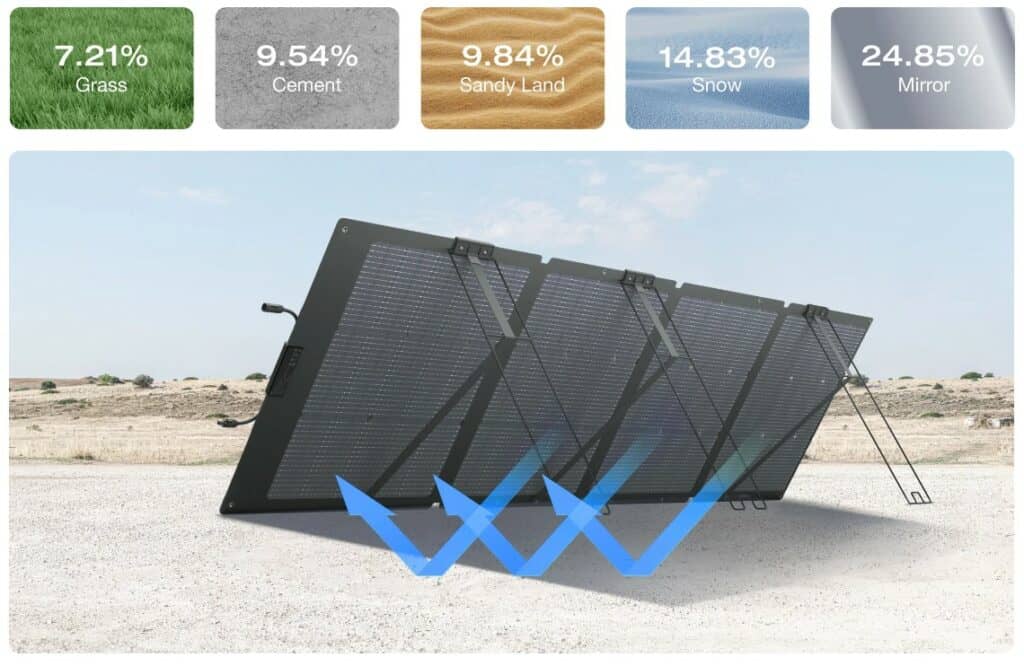Table of Contents
‘Efficient’ and ‘efficiency’ are such commonly used words that it can be easy to misunderstand their meaning when applied to specific resources and devices, such as fuel and solar panels.
Cambridge defines ‘efficient’ in two different ways:
- working or operating quickly and effectively in an organised way
- working in a way that does not waste a resource (= something valuable such as fuel, water, or money)
The second definition obviously applies to solar panels, but what does it really mean?
And how is solar panel efficiency measured?
Read on to find out.
What is Solar Panel Efficiency?
The efficiency of photovoltaic (PV) modules — like solar panels — measures how much available sunlight can be captured and converted to electricity by solar cells based on the module’s surface area.
Most solar cells are made from pure monocrystalline or polycrystalline silicon that harvests photons from sunlight and converts them into direct current electricity using the photovoltaic effect.
When you’re first shopping for solar panels, you may be surprised by how low the percentages are for even the highest rated PV modules.
The best rigid solar panels currently available have a maximum efficiency rating of ~23%.
To understand why the percentages are in the teens and low twenties for even the most efficient panels, it’s essential to understand how the number is calculated.
Standard Test Conditions for Solar Panels
| Condition Type | Standard Test Condition | Real-World Conditions |
| Solar Incident Angle | Always zero, irradiation beam always normal to the PV panel* | Variable, and depends on time, date, and site latitude. In the case of rooftop systems, roof orientation, and inclination govern system capacity. |
| Solar Irradiation | Always equal to 1000 Watts/m²* | Variable and depends on the time, date, and site latitude. Limited sunshine hours bound system capacity. |
| Ambient Temperature | Always 25°C* | Variable and depends on the time, date, weather condition, and site latitude. Higher ambient temperature degrades PV panel efficiency and reduces system output. |
| Air Mass Coefficient (AM) | Always equal to 1.5* | Variable and depends on the time, date, and site latitude. Higher AM with higher latitudes. |
| System Losses (e.g., Wiring, Inverter) | Always Zero* | Variable and depends on the design and location of PV panels, inverter, and grid meter. |
*Cannot be achieved in real-world operation (Source: ResearchGate)
All performance-related ratings for photovoltaic modules like solar panels are determined in a lab under Standard Test Conditions as shown above.
The crucial metrics to you should use to evaluate solar panel performance are efficiency (measured as a percentage) and rated power (measured in watts).
Efficiency measures how much of the sun’s energy can be transformed into DC electricity per square meter of photovoltaic material in ideal conditions, including:
- Peak sunlight (Solar Irradiance equal to 1000 Watts/m²)
- Ideal temperature (25°C)
- Optimal angle and positioning (Solar Incident Angle is zero)
Rated power measures the maximum amount of electricity a solar panel can generate in watts.
Standard Test Conditions rarely — if ever — occur in the real world.
All photovoltaic modules generate less than their rated power for much of the day and none at all at night.
For example, even the most efficient 400W rigid solar panel may only produce about 250W-300W during early morning and sunset.
Production will also be diminished on overcast days.
The higher the solar panel’s efficiency, the more power you can generate from the available sunlight.
Learn more about how to calculate solar panel output.
Does Solar Panel Efficiency Reduce Over Time?
High-quality solar panels are remarkably durable and typically last for decades before needing to be replaced.
However, all solar panels gradually become less efficient over time, at a rate of about 0.5-0.8% per year.
For example, a solar panel with 23% efficiency degrading annually at 0.5% will have an average efficiency rating of 22% after 20 years — a decline of about 4.3%.
Nothing is immune to the passage of time, but solar panels hold up surprisingly well — even in extreme cold and heat.
Common Misconceptions About Solar Panel Efficiency
Most of the misconceptions about solar panel efficiency stem from a misunderstanding of what “efficiency” actually measures as a technical specification.
Even the highest quality solar panels have an efficiency rating of about 18-23%.
Low-efficiency thin-film panels often have efficiency ratings as low as 5-8%
Why Is Solar Panel Efficiency Important?
Solar panel efficiency measures how much electricity you can generate from available sunlight per square meter.
Understanding efficiency is essential to making an informed purchase decision of a solar panel array and balance of system — particularly for residential use.
Fortunately, the average efficiency rating of PV modules has significantly increased in recent years, and prices have dropped.
Here’s why efficiency matters.
More Effective Use of Space
Installation space is at a premium In most residential solar applications.
Whether you opt for a rooftop, ground, or balcony installation — or a hybrid of each — it’s essential to mount your PV modules in a clear, unobstructed space that receives the maximum amount of sunlight during peak hours.
The higher the efficiency of the solar panels, the more electricity they will generate per square meter of photovoltaic materials.
If you’re looking to produce sufficient power to supply a substantial portion of your household electricity needs — or go completely off-grid — you’ll need to understand efficiency to plan your installation layout and, potentially, how many panels you need.
For example, a 100W rigid solar panel with 23% efficiency has the potential to generate almost 30% more electricity per m2 than a 100W PV panel with an efficiency rating of 18%.
Maximise Return On Investment
The main reason that people opt for lower-efficiency polycrystalline and thin-film solar panels is that they’re cheap.
High-efficiency monocrystalline PV cells are made from a single crystal of pure lab-grown silicon and can achieve an efficiency rating of up to ~23%.
But, the manufacturing process is more costly than poly solar panels, and it requires more raw materials.
Nonetheless, when it comes to purchasing a solar panel array, saving a bit of cash upfront by investing in cheap goods is almost always a false economy.
At best, solar is a mid-to-long-term investment — at least financially.
By generating more electricity from the available installation space on your property, you can save more money on electricity bills or eliminate them altogether.
Over time, higher-efficiency solar panels shorten your solar payback period and maximise your return on investment.
Increase Energy Independence and Security
Using high-efficiency solar panels can reduce your family’s reliance on grid electricity, helping provide energy security.
With the sharp increase in extreme weather events like floods and heat waves, blackouts are becoming more frequent.
Make sure your solar panel system can provide at least enough electricity to run your essential appliances and HVAC systems in case of a power outage.
Calculating your household electricity consumption in kWh is vital to making a smart solar purchase decision.
It’s also essential to note:
Grid-tied solar power systems DO NOT work during a blackout.
Instead, they shut down automatically to avoid injury to utility workers and further damage to grid infrastructure.
Consider investing in an off-grid solar generator or hybrid solar + storage solution for home backup applications.
Factors That Affect Solar Panel Efficiency
The efficiency rating of solar panels is determined in a lab using ideal environmental conditions.
In the real world, many factors can impact solar panel efficiency and how close to the maximum rated power output the modules can produce.
Here are the key factors to take into consideration.

(Source: Bureau of Meteorology)
Solar Resource (Available Sunlight)
Technically, the amount of sunlight at your location DOES NOT affect solar panel efficiency.
Because all PV modules’ efficiency ratings are determined in a lab, the amount of sunlight you actually receive will not change the percentage.
However, because solar resource is the #1 factor determining how much electricity your solar panel array will produce, we’ll make it first on the list.
Australia has no shortage of sunlight.
In 2024 alone, annual revenue from the sunscreen and protection market is projected to grow to $440M.
Despite an abundance of sunshine, most people will still want to maximise electricity generation potential by making the most efficient use of their available space.
Temperature
You may be surprised to learn that extreme heat is actually BAD for solar panel efficiency.
Solar panels generate electricity from the energy in sunLIGHT, not heat.
Many utility-scale solar farms in locations that seem ideal for electricity production — for example, in a desert — actually need to cool the PV panels to maximise efficiency.
Fortunately, despite 25°C being the ideal ambient temperature for solar panels, it rarely gets hot enough in most parts of Australia to significantly impact efficiency.
Efficiency begins to diminish substantially in ambient temperatures of over 37°C.
Like the rest of the world, Australia is getting hotter, but 37°C is still outside the average temperature range for most of the country.
As for cold, solar panels perform well, even in subzero conditions.
Obstruction and Shade
Regular shade from trees, buildings, or other obstructions during significant stretches of the day will significantly diminish how much power your solar array generates.
Dust, Dirt, and Debris
Anything that obscures the photovoltaic cells in your PV modules from sunlight will reduce electricity production.
Rain often does much of the work, but it’s essential to keep the surface of the panels clean — particularly in dusty or sandy environments.
Direction, Angle, Positioning, and Tilt
Not only is the placement of your PV panels crucial to electricity generation, but orientation also has a significant impact.
For example, many utility-scale solar farms use PV modules with tracking mechanisms that automatically change panel orientation during the day to maximise sunlight capture and efficiency.
The added expense won’t make sense for most residential installations, but much can be done to optimise panel orientation and electricity generation potential.
Age
Solar panel efficiency does decrease with age.
The average decline in efficiency is about 0.5 – 0.8% per year.
Despite that, most solar panel arrays won’t need to be replaced for 25-30 years.

How To Maximise Solar Panel Efficiency
Switching to clean, renewable solar power can be an excellent investment — both financially and in the future of our planet.
Maximising the electricity generation potential of your solar power system is the best way to ensure your investment pays off.
Here’s how.
Measure Twice, Cut Once
Getting the most out of your home solar energy system requires meticulous planning and a fundamental understanding of many concepts mentioned in this piece.
If you haven’t got the time or inclination to learn about the details of maximising solar panel efficiency and electricity generation, consider working with a reputable installer in your area.
Optimise Orientation
Determining the optimal orientation and mounting your solar panel array is an art unto itself.
The goal is to maximise the amount of solar irradiance (sunlight) hitting the photovoltaic surface of your panels — especially during late morning and early afternoon hours when solar energy is at its peak.
If you don’t feel comfortable with calculating the best direction, angle, positioning, and tilt for solar panels at your location, consider working with a professional installer.
It may save you a considerable amount of cash in the long run.
Keep Your Array Clean
Solar panels are designed to survive even the most extreme weather conditions, but it pays to keep them clean.
Fortunately, cleaning solar panels is easy to do.
If you have a rooftop installation and are concerned about safety, solar panel cleaning services are relatively affordable, and there’s likely to be one near you.
Consider Reflective Surfaces and Devices
A recent study found that “simple artificial ground reflectors” can increase the electricity output of solar panels by up to 4.5%.
Reflective surfaces like mirrors and foils are particularly effective with bifacial solar panels, which utilise photovoltaic cells on both the front and back of the unit.

For example, EcoFlow’s Next-Gen 220W Bifacial Portable Solar Panel can generate almost 25% more electricity when mounted on a mirrored surface.
Bifacial solar panels also excel at capturing ambient sunlight.
Think Long Term
We’re all aware of the temptations and perils of buying the lowest-priced version of any product.
Investing in residential solar power systems requires a substantial amount of money — even if you try to do it on the cheap.
Over time, you can see a significant return on your investment, primarily through saving money on your electricity bills or getting rid of them completely.
However, unless you use financing to purchase your system, the upfront costs will take time to recoup.
Fortunately, many manufacturers, like EcoFlow, offer direct-to-consumer financing at low-to-no interest rates.
The months or years it takes before you recoup your initial investment and start making money is called the solar payback period.
There are many reasons besides saving money to switch to solar for home electricity, but it pays to crunch the numbers.
Investing in high-efficiency solar panels and balance of system components like inverters and solar batteries — or an all-in-one portable power station — is likely to maximise your ROI over the mid-to-long term.
Highest Recorded Efficiency Rating of Monocrystalline (Top) and Polycrystalline (Bottom) Silicon Photovoltaic Cells 1975-2020 (Source: NREL)
Has Solar Panel Efficiency Improved?
Thanks to technological innovation and rising demand, the efficiency of solar panels has dramatically increased since 1980.
The above chart shows the maximum efficiency ratings achieved in experimental monocrystalline and polycrystalline solar cells and offers a clear picture of how PV technology has improved.
The current record for experimental PV cell efficiency is 47.6%, but this technology is not yet commercially available.
Average Installed Cost for Solar Photovoltaics Worldwide From 2010 to 2022 in USD per Kilowatt (Source: Statista)
At the same time, prices have fallen due to rising demand and economies of scale.
There’s never been a better time to invest in a solar power system for your home.
Frequently Asked Questions
The most efficient solar panels that are commercially available have an efficiency rating of +/- 23%. Experimental technologies have approached efficiency ratings of X%, but it is unlikely that they will be available in the near future due to their high cost. A good efficiency rating for monocrystalline PV panels is 20-23%, for polycrystalline: 15 – 18%.
No electrical system is 100% efficient. Power is always lost somewhere along the line. For example, electricity sent from a power plant to your house through power lines decreases an average of 8% through transmission and distribution over distance. Solar panel efficiency continues to improve significantly but will never reach 100%
Final Thoughts
The concept of solar panel efficiency isn’t easy to grasp…
Hopefully, this guide has been some help.
When it comes to selecting the right solar panels for you, weigh up the long-term savings from increased electricity generation vs the upfront costs.
EcoFlow offers a wide variety of portable, rigid, and flexible solar panels and industry-leading off-grid and hybrid solar generator solutions.
Check out our selection today!


